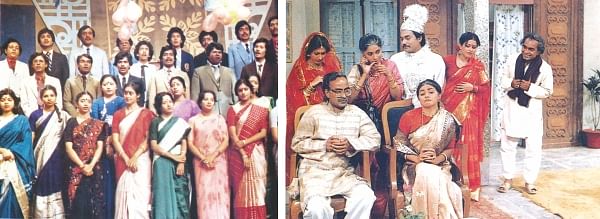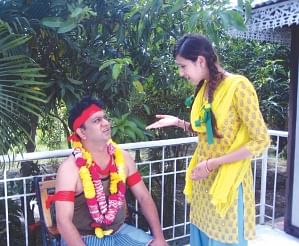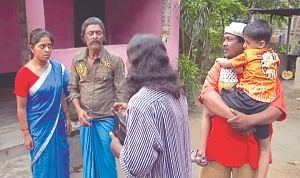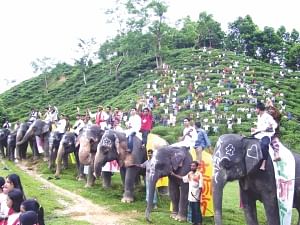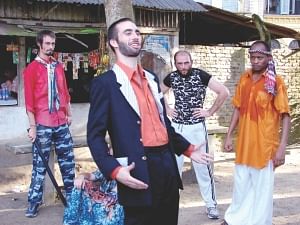| Home - Back Issues - The Team - Contact Us |
 |
| Volume 10 |Issue 33 | August 26, 2011 | |
|
|
Entertainment Television Now and Then Even with the variety, longevity and splendour of television programmes
aired nowadays during Eid, the twenty-three TV channels in Bangladesh
suffer from a lack of dedicated viewers Tamanna Khan
There was a time when people in Bangladesh used to try their best to stay at home on Eid day from 8:30 pm onwards. Some even went as far as praying to the Almighty so that an untimely guest would not appear at the door at around that time. In those days, the living room in people's houses were called TV rooms and the entire family — from grandparents to grandchildren, including the household help all sat in front of the magic box in great anticipation. Sixty-year-old housewife, Khaleda Ahmed, as a matter of fact, had to make room for more. “The first television set in Jessore town came to our house in 1966,”she says. The entire neighbourhood would pour in her house to watch whatever was aired; so much so that once her father-in-law fearing that their first floor ceiling might come down with the weight of people, shifted the television set downstairs, in the yard. The joy of watching television programmes in those days, according to Khaleda was more in the social bonding it created, rather than the content and quality of the programmes. Noted television producer, M Barkat Ullah, who had joined Bangladesh Television (BTV), then Pakistan Television Corporation in 1967, says, “You have to understand the psychological aspect of the situation. At that time television had just arrived in East Pakistan. People were very excited about it. These eager viewers liked whatever that was shown.” He recounts how difficult it was to work in the small studios at the DIT building within limited opportunities. “Professional artistes had not yet evolved then. We had to train artistes, write and explain scripts and present the programmes. Moreover most of the programmes were aired live,” adds Barkat Ullah, who is currently working in the Department of Film & Media, Stamford University, Dhaka.
Writer Selima Rahman married to a government official whose family had the privilege of receiving the first batch of Toshiba televisions in the mid- sixties, says, “we had to put the antenna on the rooftop. But the reception was so bad that someone always had to go and fix it from time to time. Still we sat in front of the TV like leeches.” Recalling the amateur looks of the shows, she comments, “At that time, they could not do good make-up. Whilst make-up can now even turn plain people beautiful; at that time it often made beautiful people look hideous.” She narrates how during talk shows even noted personalities would twitch their ears or pick their nose or shake their legs unmindfully. “Sometimes they looked at the camera and asked 'should I stop?'. They hardly realised that viewers were also watching these actions,” Selima chuckles. Today with 23 TV channels in Bangladesh airing programmes 24/7 such incidents are unthinkable. Advisor (Programme), ATNBangla Ltd, Nawazish Ali Khan, who started his career as TV producer in 1967, thinks that present-day programmes are far better in quality than before. “In comparison to the past, technical aspects of programmes have developed tremendously. The formation of a production has highly improved. There is more variety now,” he opines. He says that since more money is invested now, the brightness and dynamics of programmes have become better. However, in Nawazish's opinion past programmes had better content. “In BTV, we used to emphasise a lot on the content. But there has been huge change in social situation, values and sense of aesthetics. Now people's expectations have changed. They like fast things. They look out for the outward appearance of stuffs and their bright looks.” Nawazish remembers how BTV producers had to make do with insufficient funds and equipment. “We used to show the same bed in the house of a zamindar, an industrialist and even a middle-class family. Whether for the strength of the plot or the content, this shortcoming hardly came to our notice. Now, we cannot even think that we will use the same bed in all the programmes,” he says.
Yet viewers still speak with a hint of nostalgia about the programmes shown in the BTV era. “I remember Amjad Hossain's Taka Den Dubai Jamu. It was aired in the early days of BTV. Then there was Aanandamela. Special dramas played by Shuborna Mustafa and Afzal were also aired,” reminisces Khaleda. Amjad Hossain, creator of the popular character, Jabbar Ali, who appeared in BTV almost every Eid, says that this drama always focuses on contemporary issues and corruption. Jabber Ali, played by the writer himself, tries to make money through wicked means and gets into trouble and learns his lessons on Eid day. Although the drama is still aired in different private channels, it has lost its former popularity. “Many of the artistes, with whom I had started, like Ayesha Akhtar and Saifuddin are no more. Nobody performs the roles like they did,” he says. However, as a viewer Selima feels that acting skills have risen to a professional level now. “The acting was not great and the artistes were hesitant. Now the artistes are more natural,” she comments about the performances of the late 60s and early 70s. Wellknown actress Sharmili Ahmed, acting in television since 1968, believes that channels have created employment for artistes and technicians. “Acting in BTV was more like a hobby. There would be a drama sometimes at a gap of three months. So it was more like a pastime.” Sharmili says. On the other hand, the spirit and seriousness of working as a team for a programme has receded, which according to Nawazish, affecting the content of TV drama. Sharmili recalls working dedicatedly at least for 15 days for only one Eid drama during BTV days. “There would be five to six days of rehearsals. We used to sit together to decide the costume and getup. Because there were only two studios in DIT, the live programmes were aired during the day and at night after making the set, the drama was recorded throughout the night,” she says, with a nostalgic smile. Nowadays, rehearsals hardly take place and artistes work simultaneously in more than one drama in a week. The pressure of making a living through performance nonetheless affects their concentration in acting.
The abundance of TV programmes also affects the concentration of viewers. Referring to the monopoly BTV enjoyed in Bangladesh till the twenty-first century, Nawazish says that today viewers are exposed to the best programmes of the world and competition has become tougher for local TV channels. Barkat Ullah adds that viewers were dedicated because they could watch a one-hour programme without any break. “There weren't too many advertisements. Ads were aired at the beginning, in the middle and then at the end.” Nawazish explains the reason for showing too many advertisements. “During Eid, advertisers want their product ads to be aired in most of the prominent channels. So a pressure is created. Secondly, during Eid, expensive programmes are aired. From where will the money for these programmes come? Every channel is a business house. So if they cannot earn enough money they will not be able to survive.” He states that BTV was free from these pressures because there was no question of profit or loss. Since too many advertisements distract viewers, they move on to another channel using their TV remote, a device that Barkat Ullah considers to be the biggest enemy of TV programmes. He says that viewers today are restless and their tastes vary a lot. To hold on to such viewer-dedicated channels, airing only one genre of programmes should be established in Bangladesh. In addition, a policy for advertisement should be developed to limit excessive airing. While people no longer plan and keep their Eid evenings free for TV programmes, they still wait for Ittyadi, a magazine show that has retained its popularity over the decades. Hanif Sanket, producer and director of Ittyadi, believes that honesty, sincerity, hard work, devotion and love for the programme are the reasons behind Ittyadi's continuous success for the last twenty years. He says that with the advent of private channels producers are at full liberty to make whatever programmes they want with a lot of investment. Yet the variations in programmes are negligible. According to Sanket the number of good programmes and performers that should have evolved along with the channels is but few. “Most people now work for commercial purpose. They think that if I can give eight dramas in eight channels or ten or 20 programmes in ten channels that is more profitable. If they can earn Tk 10, 000 for one programme then by making 10 programmes for 10 channels they can earn Tk 2 lakh taka. However we think differently,” he says. Sanket highly values viewers' yearning for Ittyadi and gives his best effort in satisfying their expectations. Television still is a major source of entertainment for Bangladeshis. It is time that channel owners and programme makers think about their survival and popularity by seriously taking viewers' preferences into consideration. Too many channels clutter viewers' memory. However, a good programme aired during a festival can always stand out and leave a lasting impression. Such programmes may even help solve Dhaka's traffic problem, by luring people away from the streets to the once much-coveted spot at home, right in front of the television set.
Copyright
(R) thedailystar.net 2011 |
